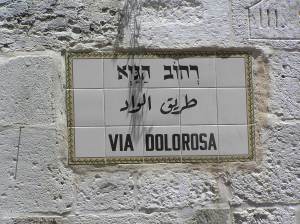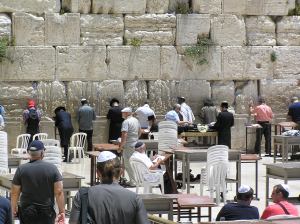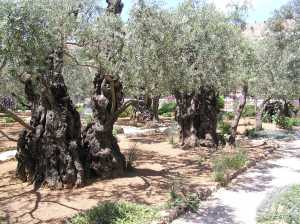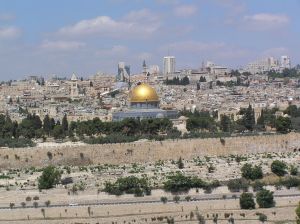The first day of our trip to Palestine began at the Premier Inn near Heathrow airport, with the alarm going off at 4am. We dressed and packed our cases and set off for the T1 car park, too early for breakfast we hoped to eat something at the airport. We met with the other members of our group from Amos Trust, then checked in and eventually boarded our flight Ba165 which left on time at 8.15. We duly arrived at Tel Aviv at 3pm local time (2 hours ahead of UK time) and collected our bags.
Passport control at Tel Aviv was stricter than anywhere else I’ve been as our passports were closely scrutinised and we were asked questions about what we were there for and who we were going to meet and where we intended to go, before being issued with our visa valid for 3 months. This was in the form of a small card like a business card with our photo on it.
We then had to wait several hours before we could leave the airport as our group leader was taken away to be more closely questioned and kept waiting before being allowed through. Eventually though we were able to board the bus and travel to Jerusalem. I won’t mention that we managed to leave one of our group at the airport! We eventually arrived at the National Hotel in Jerusalem in time for dinner and then settled into our room for the night.
Our first full day in Israel began at 7am with breakfast. We were only staying here for the one night, so suitcases were packed and loaded into the bus before we set off for the day.
SABEEL
Our first visit was to the Ecumenical Liberation Theology Centre, known as Sabeel, in Jerusalem. Sabeel was estsblished in 1948 and means “The Way” or “A spring of fresh water”. We were met by one of the founders who gave us a passionate talk about her life and experiences and the struggle to form a theology that speaks meaningfully into the situation of the Palestinian people.
C told us that she was brought up in Haifa where, as a child in the1940s, she remembers the grown ups talking about the many ships that were arriving with Jewish migrants from Europe. This was met with mixed views by the local community since some felt that they would be overrun if the immigration was allowed to continue, others felt it was their humanitarian duty to be hospitable and to help people who had suffered greatly from persecution and the holocaust.
The following are my notes from her talk:
Christian theology played a part in the creation of Zionism and the Zionist narrative on which the state of Israel is based Jews were often persecuted by Christians who blamed them for the crucifixion of Jesus. The Zionist view is that Jews must never again be in the position of being a minority, that they must retake the land given to them by God as described in the Old Testament in the book of Exodus.
However God is a God of justice – the land must accomodate two peoples – Palestinian and Jewish otherwise it will always be a place of unrest. “Palestine” is not an ethnicity – Palestinians are the people who live in Palestine (or lived there before being expelled) and include Jews and Christians as well as Muslims and people of various ethnicities. 1/5 of people who live in Israel are non-Jews. Many Palestinians have lived on the land for generations and many can claim to be descended from the original Canaanites who were living in the land in Old Testament times.
Following the establishment of Israel in 1948 people of 500 villages in the Gallilee region were forced to flee their homes, often at gun point. These people fled to places like Lebanon or Jordon or to other Palestinian cities like Nazareth or Bethlehem. Many believed it would be only for a few days and that the international community would not allow this to happen, but they were never allowed back to their homes and many still live in refugee camps today 65 years later. Many are now third generation refugees and one reason many remain is that they wish to retain their “right of return” which they have under international law.
The government of Israel is trying to change the definition of “refugee” so that it applies only to the people who were expelled from their homes, not their living descendants. This would mean that most of the people living in the refugee camps would be left homeless and stateless.
The people in the refugee camps are now largely Muslim because many of the Christian refugees were helped by churches to set up homes elsewhere.
There are 5 groups of Palestinians:
- 1.6 m in Israel;
- The residents of East Jerusalem (34% of Jerusalem and falling, Israel wants to see this figure fall to 12%).
- West Bank – Areas A, B C
- Gaza
- Refugees scattered in Arab countries such as Jordon or Syria.
No other state in the world is currently built on ethnicity or religion alone – yet Israel wants a “Jewish State” – what does this mean in reality? How can this be achieved without discrimination on grounds of religion or ethnicity?
The Jewish people have been scattered since AD 70. They have often led a difficult life as a persecuted minority. The Christian world feels guilt for this and the need to atone for the antisemitism that led to the holocaust. The Bible has been part of the problem – it must also be part of the solution.
Josuha 6 – the flight from Egypt is a story of liberation, as far as Jewish people are concerned. But if they are the “chosen” people then what of the “unchosen” (ie the rest of us). Palestinians are the people driven out.
In 1948 10% of Palestinians were Christian. They were educated from the point of view of British missionaries. The dominant story of the Bible is the Jewish story – the people of the land didn’t matter. The situation is the same today – the Palestinans are the “burnt offering” for the fate of the Jewish people. How can we read the Bible today from the point of view of the “unchosen”?
Israel has no constitution. How is it possible to define what is a Jew? Many are secular with no particular religious belief or practice only 27% are religious. 1.1% of Palestinians are now Christian.
TOUR OF JERUSALEM
From Sabeel we were led by our guide for the day (one of 43 Palestinians authorised to work as tour guides in Israel). As a guide he is able to stay in Jerusalem but as a Palestinian he is not allowed to rent or live there, to drive or do anything other than tour guiding. Most Palestinians are not allowed to go to Israel without obtaining a special permit. He is a Christian and was very knowlegable about the Bible.
First we went to the Mount Of Olives – to a small church supposedly in the shape of a tear drop, reminding us of the time that Jesus looked across the valley to Jerusalem and wept (Luke 19:41). We had a fantastic view accross Jerusalem with the Dome of the Rock on the Temple Mount at the centre. This is the site where Isaac was almost sacrificed by Abraham in the Genesis story. For Muslims it is a holy site because it is where Mohammed was brought on the night journey mentioned in the Quran. To the left is the Al Aqsa mosque – the third most holy place for Muslims.
This area is where the first and second temples were built although only the foundations remain after it was destroyed by the Romans in AD 70.
From there we descended to the “Garden of Gethsemene”. This is one of several possible places that represent the garden where Jesus prayed and was arrested. But authentic or not it contains some ancient olive trees that apparantly could be 2000 years old.
The Mount of Olives also has many cemetaries because this is the place where the Messiah is expected to arrive first. Muslims are burried accross the valley under the city walls.
We drove down to Jerusalem stopping at Silwan where Palestinian houses are being demolished to make way for a garden.
We entered the old city through the Dung gate and walked to the Western wall plaza.We spent some time there. And then We then walked through the souks in the Arab quarter to the start of the Via Delorosa – the church of the flagelation.
We followed the stations of the cross to the Church of the Holy Sepulcre, and then lunched at a local cafe where we met our first falafels and delicious lemonade with mint.
We walked back through the souks and out of the Zion gate and on to the site of Caiaphas house – which contains a pit where Jesus is thought to have been kept over night and tortured after his arrest.
We then drove out of Jerusalem and through the check point into Bethlehem where we settled into the Ararat hotel.




